Effectiveness of actions to reduce harm from nuisance calls in Scotland
Research commissioned to analyse the impact of actions set out in the Nuisance Calls Commission action plan, and to examine the outcomes of past interventions.
3 The situation in Scotland
3.1 Introduction
The first part of this report looked at the UK as a whole, which of course includes Scotland. This part now looks harder at Scotland itself. The situation there appears to differ from the rest of the UK in the following important respects:
- Ofcom omnibus consumer issues surveys suggest that rather more people in Scotland remember receiving nuisance calls than in other countries of the UK, and Ofcom landline nuisance calls diary surveys suggest that people in Scotland who receive nuisance calls receive more of them than in other countries of the UK [57] .
- Statistics for trueCall users show Scottish users receiving far more nuisance calls than similar types of user elsewhere in the UK - in the first half of 2017, standard trueCall users in Scotland were receiving 26 nuisance calls a month compared with 17 a month in the rest of the UK. Disproportionately high levels of calls about home improvements, and to a lesser extent survey calls, account for a large part of this difference.
- Scotland has one of the highest rates of call centre employment in the UK, with a particular concentration of call centres in the Glasgow area. A high proportion of Scottish agents are engaged in outbound calling, accounting for some 40,000 jobs. And some Scottish call centre outbound campaigns focus on Scotland.
- Public funding for improvements to make homes both warmer and more energy efficient has continued in Scotland, while national Green Deal funding stopped in July 2015. trueCall data show that a high proportion of unwanted calls from major call centres targeting Scottish recipients relate to home improvements, and many of these calls appear to originate from call centres based in Scotland.
- The legal system in Scotland is different in some respects. In particular, legislation for the protection of vulnerable adults in Scotland preceded similar legislation in England and Wales. This has prompted some local authorities to install call blockers in the homes of people suffering particularly from nuisance and scam calls; these are proving popular and effective. Also, enforcement of national regulation by UK-wide regulators fits imperfectly with Scottish systems for pursuing and recording offences.
We provide more information on each of these below, together with such information as we have on Scottish consumer behaviour. In addition Annex J presents detailed analyses of recent data from Scottish trueCall users, including a close look at the top 250 numbers making calls which were blocked by these users, and an examination of the differences between the calls received by standard trueCall users and vulnerable trueCall users in Scotland. Annex K looks at Ofcom consumer research data for Scotland and compares it with the rest of the UK and with the corresponding trueCall data.
3.2 Nuisance calls to Scotland compared with the rest of the UK
Since 2014, Ofcom’s periodic consumer issues surveys have been asking respondents about their recollection of receiving nuisance calls in the previous four weeks. We have collected results from 21 such surveys, and in only four of them is the percentage of respondents receiving nuisance calls highest or equal highest in Scotland; usually the percentage for East Midlands, North East or South West is the highest (and the percentage for Northern Ireland or London is the lowest). The percentage is higher than in Scotland in three (out of twelve) nations or regions on average, but it can be higher in as many as nine [58] . BT tells a similar story, saying that on the evidence available through its nuisance calls advice line and network information, Scottish customers receive more nuisance calls on average than those in most, but not all, other parts of the UK; in fact customers in three regions contact BT about nuisance calls more than do Scottish customers.
Figure 16 illustrates the variability [59] of these regional results, using the 9 surveys available for the past two years, with the regions arranged in order of the average results for all 9 combined. Scotland comes third, after East Midlands and Wales.
Figure 16: Landline nuisance calls by region in consumer issues surveys, 2016-17
Source: 9 Ofcom omnibus consumer issues surveys

However, if we combine all 21 surveys since 2014, and calculate 99% confidence intervals for the four countries, we get the result shown in Figure 17, with Scotland and Wales clearly having had more nuisance call recipients than England or Northern Ireland.
Figure 17: Respondents with landline nuisance calls in the previous four weeks, 2014-2017
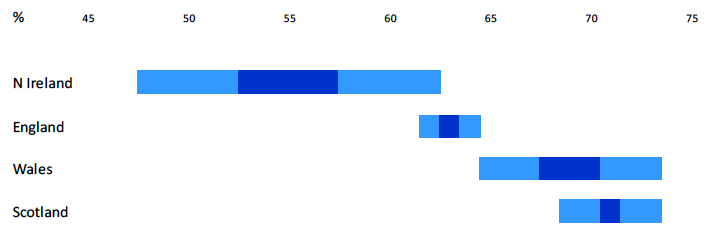
Note: Source is 21 Ofcom omnibus consumer issues surveys combined. Bars show 99% confidence intervals, with darker shading on more likely parts of bar.
Figure 18 and Figure 19 summarise a rather different picture, provided by trueCall data. As they show, the number of nuisance calls received by Scottish trueCall users (which are divided into groups called “standard” and “vulnerable” according to the settings that they use [60] ) has been consistently much higher since 2014 than the corresponding figures for the rest of the UK. Standard trueCall users in the rest of the UK have averaged around 20 nuisance calls a month, compared with 30 to 40 nuisance calls a month in Scotland.
It is notable also that the Scottish trueCall user experience has varied more with time [61] , being especially and consistently high during 2015 and mid-2016.
Figure 18: Nuisance calls per month per trueCall unit in the UK except Scotland, 2014-2017
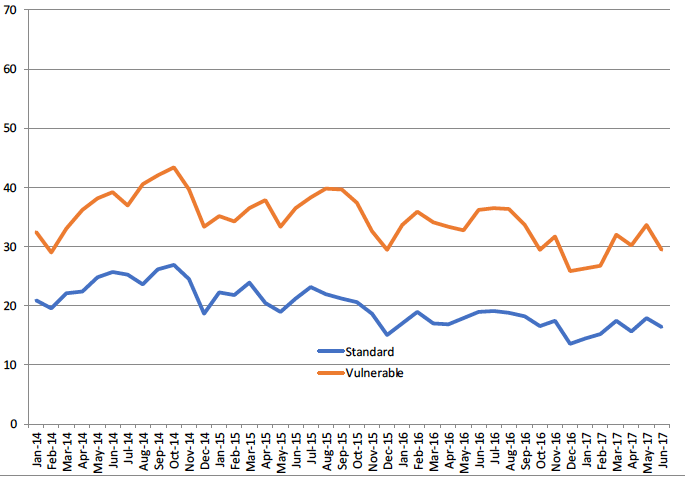
Figure 19: Nuisance calls per month per trueCall unit in Scotland, 2014-2017

Annex J provides far more detail, including comparisons between the types of nuisance calls received in Scotland and the rest of the UK, and between those received by vulnerable and standard trueCall users. Key points include:
- The top 10 and 100 calling numbers account for higher proportions of total nuisance calls in Scotland than in England (as indicated in Figure 20), probably indicating a higher proportion of activity by major call centres.
- Analysing the top 250 numbers making nuisance calls, which have been categorised by sector, Scots receive more calls in most categories, but vastly more calls relating to home improvements - nearly five times as many [62] .
- Analysing the top 250 numbers making nuisance calls, 27% of nuisance calls into Scotland come from Scottish numbers (or call centres spoofing Scottish numbers), whereas in the rest of the UK only 3% of nuisance calls come from Scottish numbers. This additional 24% could account for a big proportion of the additional calls that Scots receive. Scots receive the same or more calls as the rest of the UK from all other UK regions.
It is important to note that the “top 250 numbers” analyses naturally focus on the activities of major call centres, which are equipped for mass campaigns. They are only a small sample of nuisance calls as a whole; and as frequent changes of calling number become more widespread, the call centres and campaigns using the “top 250 numbers” will change.
Figure 20: Proportion of nuisance calls made by top calling numbers, January-June 2017
| User type and area | Quantity of calling numbers | |||
|---|---|---|---|---|
| Top 10 | Top 100 | Top 250 | Top 1,000 | |
| All UK – All users | 2.0% | 7.9% | 12.2% | 20.1% |
| English Standard | 2.4% | 10.9% | 17.3% | 28.5% |
| English Vulnerable | 3.5% | 13.5% | 20.5% | 33.2% |
| Scottish Standard | 4.7% | 13.2% | 20.4% | 29.9% |
| Scottish Vulnerable | 6.5% | 16.2% | 23.4% | 33.2% |
Source: trueCall data
3.3 Call centres in Scotland
The analysis of trueCall data on the top 250 calling numbers into Scotland has highlighted intensive calling with a focus on Scotland from certain Scottish companies and call centres. In particular, 57 calling numbers that had Scottish area codes were identified as probable sources of telemarketing campaigns, 13 of them located in call centres in Glasgow and 11 located in call centres in Kirkcaldy. More details are given in Annex J.
In the UK as a whole, about 4% of the working population is estimated to work in call centres, but in Scotland this rises to over 5%, with a higher than average proportion of outbound calling (attributed to the appeal of Scottish accents), leading to around 40,000 outbound calling jobs [63] . Call centres and the companies that use them will point to likely job losses if outbound calling is reduced, and the Scottish Government will need to take account of this, bearing in mind that to some extent, more inbound calling may substitute for less outbound.
As noted in the chapter on the UK, there is reason to believe that better treatment of customers would lead to higher job satisfaction for call centre agents. Working conditions in some call centres, especially non-unionised ones, have generated a considerable literature [64] . There must be scope for call centre agents to highlight where improvement is needed, for example through a whistle-blowing line.
3.4 Energy efficiency schemes in Scotland
ICO publishes statistics of concerns [65] , showing the call category chosen by the consumer reporting each concern. Figure 21 summarises these for the main categories that were relevant in 2014 to 2016. The most striking feature of this figure is the big drop in concerns in the category “energy saving and home improvements” between 2014 and 2015.
The drop in concerns about energy saving and home improvements was highlighted already in 2015 by David Hickson of the Fair Telecoms Campaign [66] , and linked to the end in July 2015 of UK public Green Deal funding for energy efficiency improvements [67] . In Scotland, however, as the Fair Telecoms Campaign has also pointed out, various publicly funded schemes for improved energy efficiency have continued [68] .
The previous Green Deal scheme (covering England, Wales and Scotland) included a Green Deal Oversight and Registration Body, under Government auspices. Certified providers were supposed to comply with a Code of Practice which includes provisions to limit and moderate cold calling [69] . We do not know how far these provisions were effective. No publicity is given to any similar scheme covering the Home Energy Efficiency Programmes for Scotland [70] .
Combined with the findings of the previous section, these observations suggest that a substantial part of excess nuisance calls to Scottish consumers is related to energy efficiency, with the calls either directly marketing home improvements, or gathering leads to enable such marketing by others.
Figure 21: ICO concerns by sector, 2014-2016
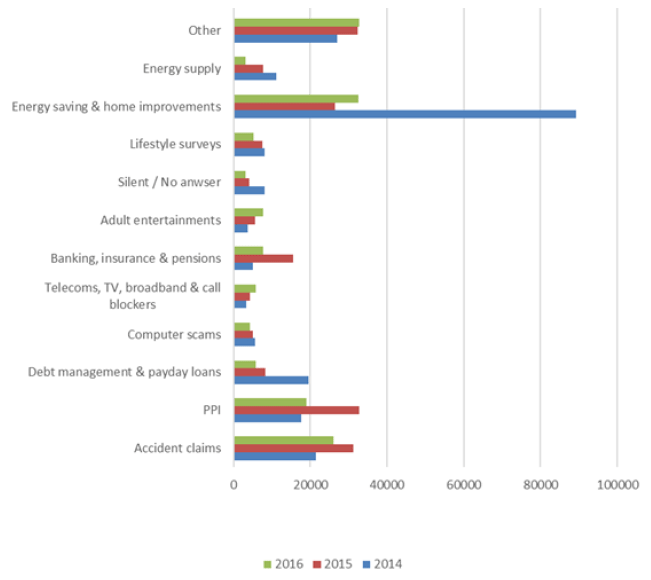
Source: ICO data compiled by this study
3.5 Legal and organisational features of Scotland
3.5.1 Call blockers for vulnerable adults
The Adult Support and Protection (Scotland) Act 2007 laid duties on local authorities in relation to protection of adults at risk of harm. Similar provisions were introduced in the rest of the UK only through the Care Act in 2014, so Scotland has been a pioneer in this area. Protection from nuisance calls has been recognised as one measure among many that may help some adults at risk, and some local authorities have made major efforts to equip vulnerable residents with call blockers. Figure 22 outlines the success of such activities in the leading area, East Renfrewshire; Angus and South Ayrshire are also working in a similar way [71] .
Continuing work of this kind by these three local authorities is supported by a £405,000 grant won in 2016 [72] , from the Big Lottery Fund Life Changes Trust, for helping residents living with dementia. Most of the funding covers staff costs, but 18% of it is foreseen for spending on technology, much of which would be aimed at preventing scams [73] . As well as producing direct benefits in the three areas, the three-year programme will lead to a toolkit for applying what is learned from it to other areas [74] .
Figure 22: trueCall call blockers in East Renfrewshire
In 2012 East Renfrewshire Council tested a range of call blocking equipment, and decided that the trueCall Secure unit was the most suitable for protecting vulnerable residents from nuisance calls. These people were receiving on average around 40 nuisance calls per month, at least double the national average. The blocking options selected for them varied according to their needs. To date over 550 units have been installed, and 95% of nuisance calls have been blocked. The Council can access online records showing calls received and blocked.
The Council believes that providing call blockers free of charge to this group is a very cost-effective use of funds, as it enables people to stay in their own homes for longer and protects their savings from scammers. The recipients and their carers are delighted with the reduction in nuisance calls. The aims are to provide blockers to all homes including someone with diagnosed dementia, and all those with community alarms; this would amount to around 10% of the homes in the Council area.
Source: Blocking nuisance calls in East Renfrewshire 2016/2017 and interview with Paul Holland of the East Renfrewshire Prevention Team.
Given their high cost-effectiveness, people close to these call-blocking activities strongly advocate extending them to many more potential beneficiaries. The Scottish Government has provided £50,000 additional funding, intended to correspond with the £500,000 made available through DCMS to the National Scams Team for similar purposes. However, it is estimated that there are over 90,000 people in Scotland with dementia, so to reach even (say) 10% of these in this way would require much more generous funding. Further Scottish Government funding of £75,000 was announced on 16 October 2017.
Another benefit of these call blockers is the detailed data derived from them, which can provide many insights into the changing face of nuisance calling (like those in Annex J) and help to track the effectiveness of harm reduction measures.
3.5.2 Other arrangements special to Scotland
Various other features of the Scottish scene deserve mention here. They are mostly helpful in the aim of reducing harm from nuisance calls; however, the additional procedure for enforcement in Scotland slows down action by UK authorities, and split systems for reporting fraud complicate statistical analysis.
Protection as a priority: Council Trading Standards departments across Scotland focus on consumer protection, including the prevention of scams by any channel. They co-operate closely with Police Scotland, who say that in general, protecting potential victims against fraud is far more likely to reduce harm than pursuing the perpetrators [75] , given the difficulty in first finding the perpetrators and then securing their conviction [76] .
Cross-authority working: At both local and Scottish levels, not just the Police and Trading Standards but also, among others, HMRC, Border Force, Scottish Environmental Protection Agency, and Food Standards Scotland come together to fight serious and organised crime. Most of these agencies have a presence at the Scottish Government Crime Campus at Gartcosh, which has greatly enhanced multi agency working in Scotland. Co-operation of this kind may be easier in Scotland than in the UK as a whole because of its smaller size, and some say more open attitudes.
Working against scams: Scams (mass-market consumer fraud) are seen as becoming an easier and more lucrative form of crime than drug dealing, so consumer protection against scams has a high priority [77] . The 2014 Citizens Advice Scotland ( CAS) report Scammed and Dangerous provides a useful, if by now slightly dated, picture of different types of scam in Scotland and their likely victims. The Police and Trading Standards lead the work against scams, with other public agencies contributing as appropriate. Private sector entities such as banks, money transfer bureaux or telcos may also need to be involved.
Common Law duty of care: We have been told that it is more clearly the norm in Scotland for people to highlight concerns about others’ well-being, fulfilling a common law duty of care, even where there could be countervailing privacy issues or victim denial of their status. For example [78] , in 2013 Scottish postal workers helped to identify fraud victims using postal items addressed to them as evidence. Banks are being asked to follow a similar practice.
Case data: It is very helpful that intelligence about reported or detected scams is shared among national and local Trading Standards bodies in Scotland through the “Memex” database system [79] . Co-presence at the Gartcosh Crime Campus also facilitates intelligence sharing between the Police and Trading Standards.
Fraud reporting: As elsewhere in the UK, it is believed that fraud, including scams, is greatly under-reported [80] . The impression of under-reporting is accentuated by the fact that Scots have a choice of reporting routes: through the Citizens Advice Consumer Helpline, Police Scotland or Action Fraud (the latter covering the whole UK). Although reports from Scottish consumers to national agencies could and should be fed back to the Scottish agencies, this has not been happening as expected, which may well be why the last year’s fraud statistics for Scotland appeared to go down when those for the rest of the UK rose.
Issue of warrants: In order to pursue a case in Scotland, ICO has to go through the Procurator Fiscal’s office to obtain a warrant that is valid in Scotland. ICO feels that this additional procedure slows enforcement and is considering alternative legal approaches [81] .
Charity fundraising calls: The recently introduced Fundraising Preference Service [82] does not apply to Scotland. Joining in was considered, but decided against on the grounds that charities in Scotland tend to be smaller than in England, there have been few complaints about unwanted fundraising calls, and that the existing Telephone Preference Service should be sufficient [83] .
Citizens Advice Scotland: the Scottish sister to the UK national advice charity has 61 bureaux (at least one in each of 31 of the 32 Scottish local authority areas) and over 200 outreach posts, including periodic visits to outlying islands. Each of the 61 bureaux has its own social media account. It is very well placed to reach Scottish consumers, has already taken part in a nuisance call awareness campaign with Which?, and devotes part of its website to useful resources for consumers.
3.6 Behaviour and characteristics of Scottish consumers
We have tried to see if Scottish socio-economic and demographic characteristics help to explain a greater incidence of nuisance calls in Scotland, but have not found any useful evidence to this effect. For example, life expectancy in Scotland is a little lower than in the rest of the UK, and correspondingly the proportion of older people in the population is no greater than elsewhere. The dispersed rural population could mean that telemarketing has historically worked well in some areas, alongside catalogues and distance sales, but for that, too, we lack evidence [84] . However, the state of the housing stock, along with the colder, wetter and darker weather in Scotland, may strengthen the need for improved energy efficiency; such effects are visible in the make-up of nuisance calls.
There are some significant differences in technology take-up between Scotland and the rest of the UK, as illustrated in Figure 23. Looked at over time, these differences are reducing. However, lower levels of internet use in Scotland may have led to continued marketing by telephone, when internet communications were more used elsewhere. If this is part of the explanation, then the level of telephone marketing would naturally approach that in the rest of the UK, as internet use rises.
Lower internet take-up (which is even lower among older and disabled people and lower income groups) [85] has implications for the design of consumer awareness and educational materials, and for complaints systems. Clearly, it is not enough to rely on websites which may be inaccessible to those who most need them.
A special survey [86] of older people and scams carried out by Age Scotland with Age UK in the summer of 2017 showed that 41% of Scottish over-65s thought they had been targeted by scammers, with 29% of these mentioning voice communications (presumably, phone calls) as the medium, second to 39% mentioning electronic communications. Across the UK, 27% of single people surveyed responded to a scam attempt, compared with only 9% of those who were married or living as married.
Figure 23 Take-up of communications services, 2017
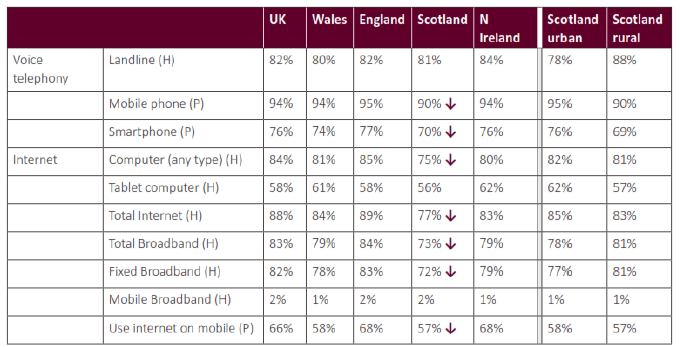
Source: Ofcom Communications Market 2017 report, chapter on Scotland; data from Ofcom Technology Tracker H1 2017. Note: Arrows indicate significant differences; H and P indicate take-up percentages relating respectively to households and individuals.
3.7 Expected effectiveness of actions in Scottish Nuisance Call Action Plan
This section applies to the Scottish Nuisance Call Action Plan the findings of our study of the effectiveness of actions to reduce harm from nuisance calls in the UK. It aims to take into account relevant special features of the situation in Scotland, as set out in this chapter.
The same colour-coded indicative effect bands are used as in the earlier effectiveness table. Note that the effect is assessed relative to the people who could be affected by it (shown in the “beneficiaries” column) – for example, the call blockers to be funded by the Scottish Government will have a major effect only for the people who get them.
We offer a few observations:
- Six actions appear to have a potentially major impact on their beneficiaries.
- Even minor effects can add up to become major if enough of them are done, and sustained; and combining actions may be more than additive, as different actions can strengthen each other.
- Scalability (as for action A1 – provide call blockers to vulnerable consumers) and sustainability (as for action D5 – develop a scams prevention strategy, which has to be implemented to be of value) are crucial considerations, in varying degrees, for all action types. For example, probably A1 cannot be applied to everyone who would benefit from it, but with the arrival of new call blocking options, it could have a catalytic role by spreading awareness of how well these can work.
- Examples set by the Scottish Government, such as displaying CLI with outbound calls (action D3), can have an indirect influence well beyond their direct effect. We do not feel able to estimate this, but expect that it would be beneficial for the whole UK as well as for Scotland.
- In other actions too, Scotland could pioneer approaches that would be beneficial for the whole UK. Action D4c), make complaining easier, is an example.
- Action D4b), get telcos to block more where technically feasible, is mainly a whole-of- UK activity led by Ofcom, but SG may be able to interest some operators in piloting new approaches in parts of Scotland.
- Similarly, new approaches to reaching hard-to-reach consumers with awareness messages (action A2) or to engaging financial partners in protecting vulnerable consumers (action C2) might well be piloted in Scotland.
- The concentration of call centres in Scotland provides an excellent opportunity for the Scottish Government and business community to raise standards of practice directly, with immediate benefits both to Scottish consumers and to call centre agents.
- The Action Plan correctly recognises that use of the telephone for scams can be addressed only in part through actions that aim to prevent nuisance calls; other actions will also be needed as part of an overall anti-scam strategy. For example, mail or email can dupe a victim into calling a fraudster, whose calls may then be welcomed.

Figure 24: Assessment of effectiveness of actions in the Scottish Action Plan
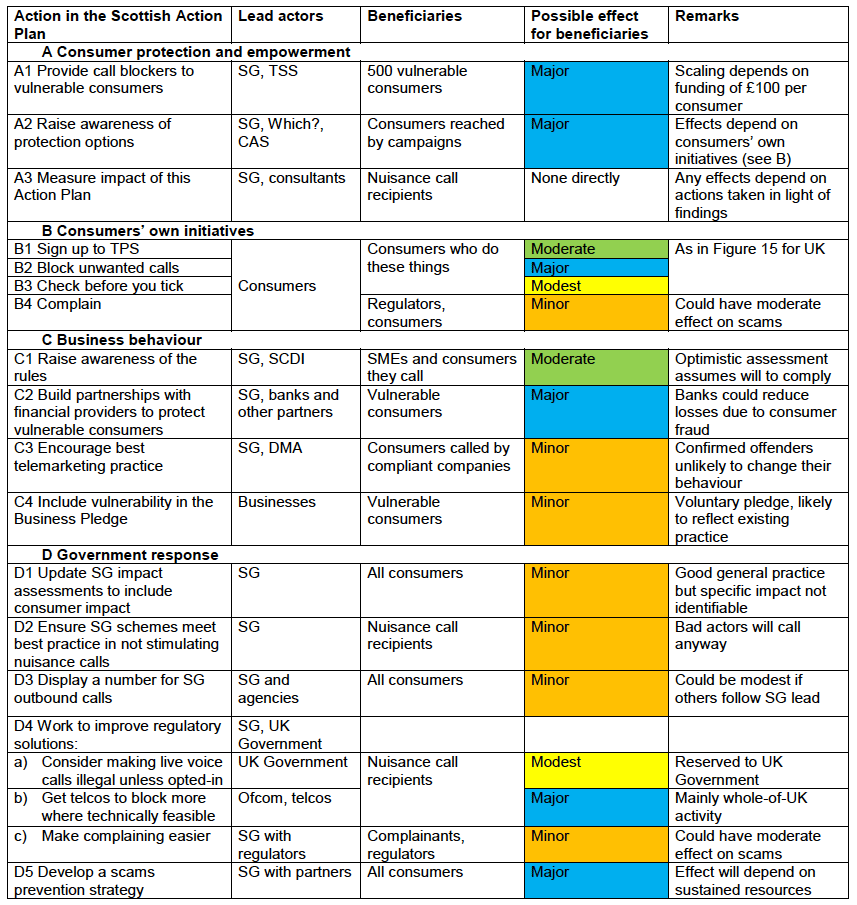
Contact
There is a problem
Thanks for your feedback